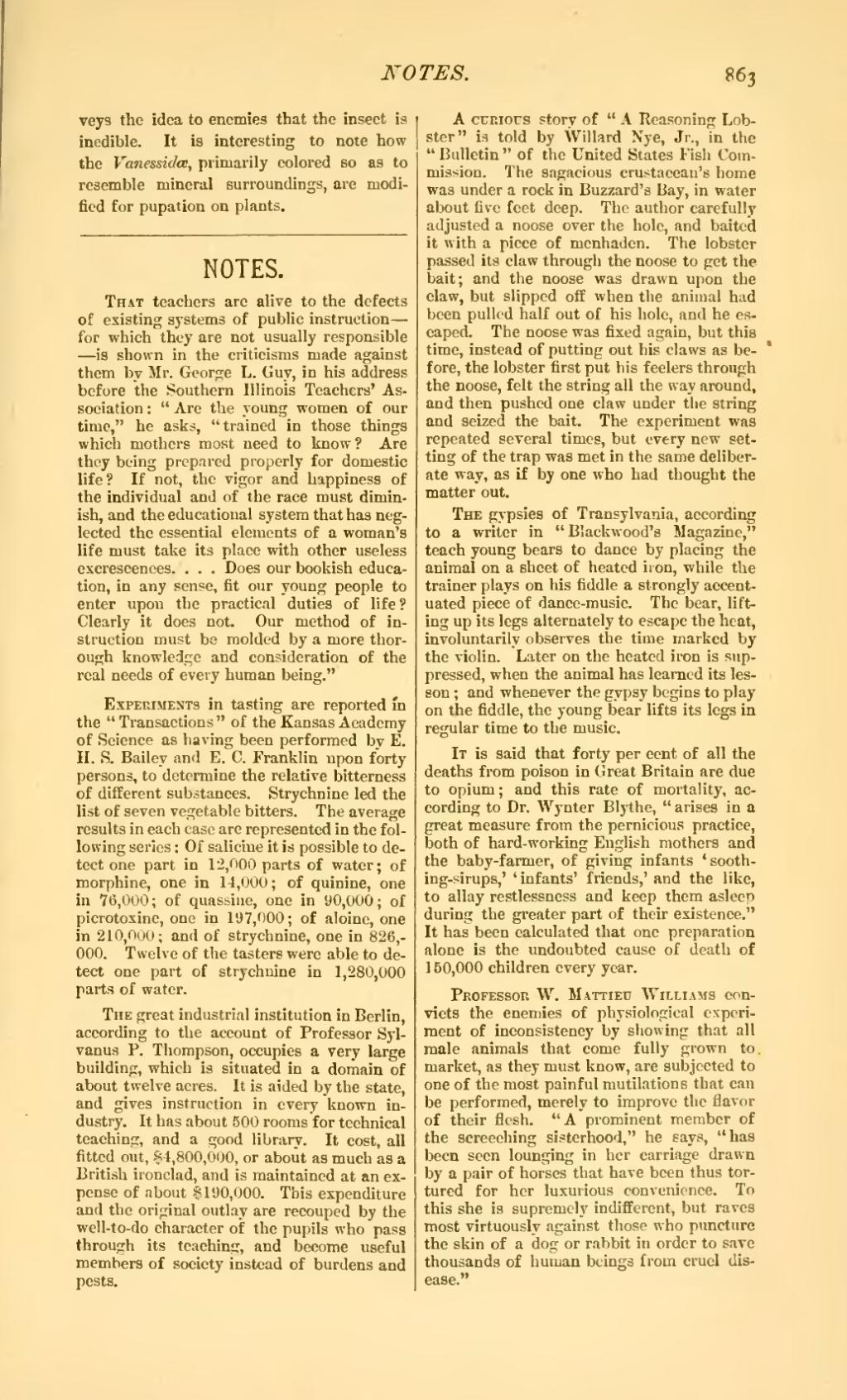veys the idea to enemies that the insect is inedible. It is interesting to note how the Vanessidæ, primarily colored so as to resemble mineral surroundings, are modified for pupation on plants.
That teachers are alive to the defects of existing systems of public instruction—for which they are not usually responsible—is shown in the criticisms made against them by Mr. George L. Guy, in his address before the Southern Illinois Teachers' Association: "Are the young women of our time," he asks, "trained in those things which mothers most need to know? Are they being prepared properly for domestic life? If not, the vigor and happiness of the individual and of the race must diminish, and the educational system that has neglected the essential elements of a woman's life must take its place with other useless excrescences. . . . Does our bookish education, in any sense, fit our young people to enter upon the practical duties of life? Clearly it does not. Our method of instruction must be molded by a more thorough knowledge and consideration of the real needs of every human being."
Experiments in tasting are reported in the "Transactions" of the Kansas Academy of Science as having been performed by E. II. S. Bailey and E. C. Franklin upon forty persons, to determine the relative bitterness of different substances. Strychnine led the list of seven vegetable bitters. The average results in each case are represented in the following series: Of salicine it is possible to detect one part in 12,000 parts of water; of morphine, one in 14,000; of quinine, one in 76,000; of quassine, one in 90,000; of picrotoxine, one in 197,000; of aloine, one in 210,000; and of strychnine, one in 826,000. Twelve of the tasters were able to detect one part of strychnine in 1,280,000 parts of water.
The great industrial institution in Berlin, according to the account of Professor Sylvanus P. Thompson, occupies a very large building, which is situated in a domain of about twelve acres. It is aided by the state, and gives instruction in every known industry. It has about 500 rooms for technical teaching, and a good library. It cost, all fitted out, §4,800,000, or about as much as a British ironclad, and is maintained at an expense of about §190,000. This expenditure and the original outlay are recouped by the well-to-do character of the pupils who pass through its teaching, and become useful members of society instead of burdens and pests.
A curious story of "A Reasoning Lobster" is told by Willard Nye, Jr., in the "Bulletin" of the United States Fish Commission. The sagacious crustacean's home was under a rock in Buzzard's Bay, in water about five feet deep. The author carefully adjusted a noose over the hole, and baited it with a piece of menhaden. The lobster passed its claw through the noose to get the bait; and the noose was drawn upon the claw, but slipped off when the animal had been pulled half out of his hole, and he escaped. The noose was fixed again, but this time, instead of putting out his claws as before, the lobster first put his feelers through the noose, felt the string all the way around, and then pushed one claw under the string and seized the bait. The experiment was repeated several times, but every new setting of the trap was met in the same deliberate way, as if by one who had thought the matter out.
The gypsies of Transylvania, according to a writer in "Blackwood's Magazine," teach young bears to dance by placing the animal on a sheet of heated iron, while the trainer plays on his fiddle a strongly accentuated piece of dance-music. The bear, lifting up its legs alternately to escape the heat, involuntarily observes the time marked by the violin. Later on the heated iron is suppressed, when the animal has learned its lesson; and whenever the gypsy begins to play on the fiddle, the young bear lifts its legs in regular time to the music.
It is said that forty per cent of all the deaths from poison in Great Britain are due to opium; and this rate of mortality, according to Dr. Wynter Blythe, "arises in a great measure from the pernicious practice, both of hard-working English mothers and the baby-farmer, of giving infants 'soothing-sirups,' 'infants' friends,' and the like, to allay restlessness and keep them asleep during the greater part of their existence," It has been calculated that one preparation alone is the undoubted cause of death of 150,000 children every year.
Professor W. Mattieu Williams convicts the enemies of physiological experiment of inconsistency by showing that all male animals that come fully grown to market, as they must know, are subjected to one of the most painful mutilations that can be performed, merely to improve the flavor of their flesh. "A prominent member of the screeching sisterhood," he says, "has been seen lounging in her carriage drawn by a pair of horses that have been thus tortured for her luxurious convenience. To this she is supremely indifferent, but raves most virtuously against those who puncture the skin of a dog or rabbit in order to save thousands of human beings from cruel disease."
